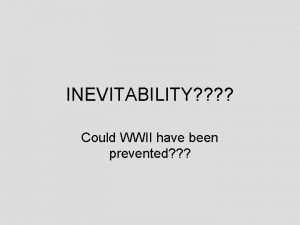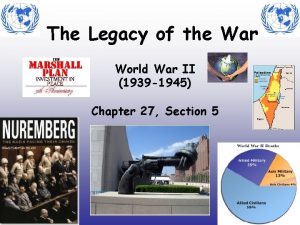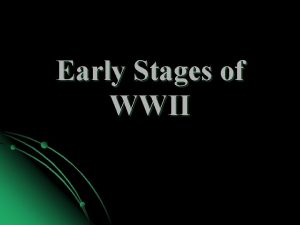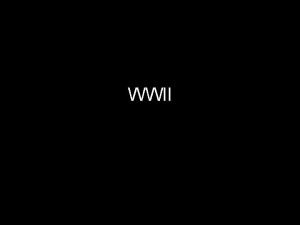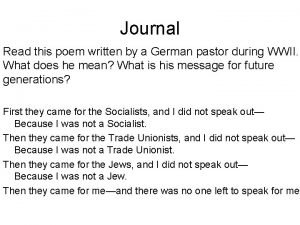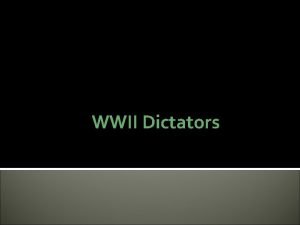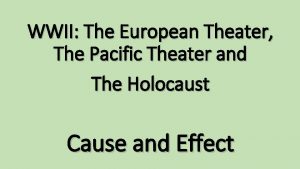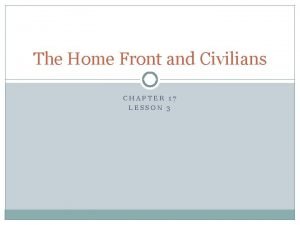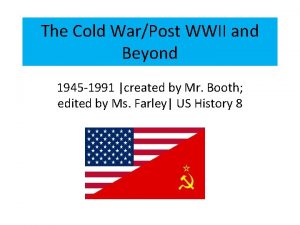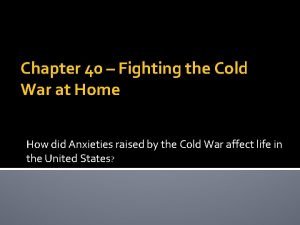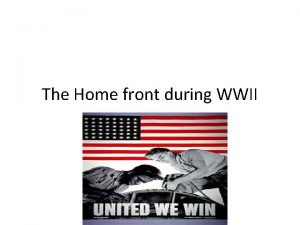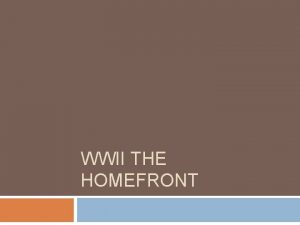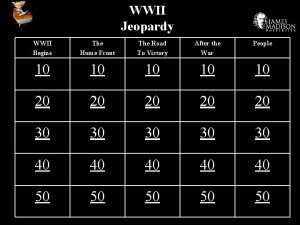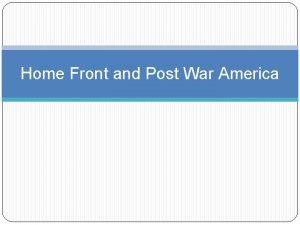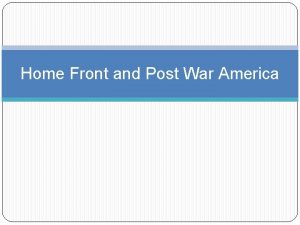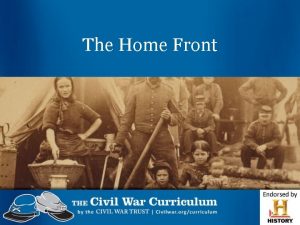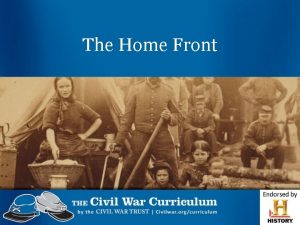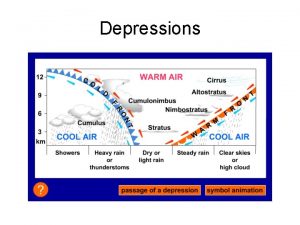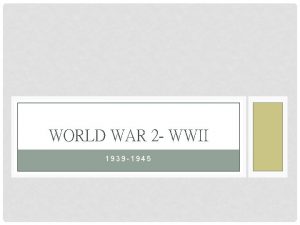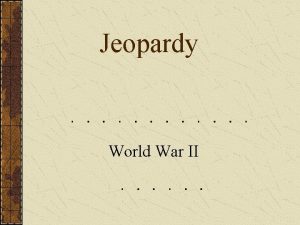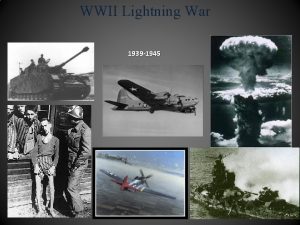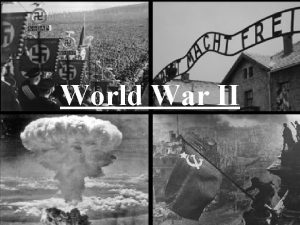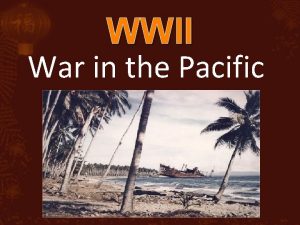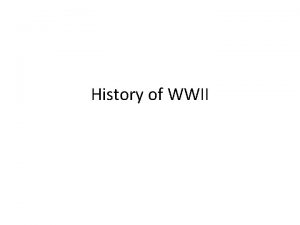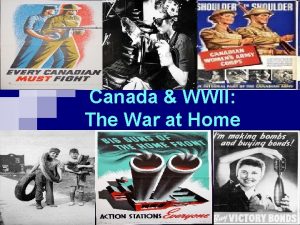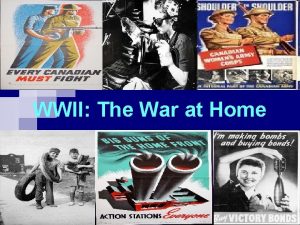WWII the US Home Front War at Home























































- Slides: 55

WWII & the US Home Front

War at Home: The Economy �Government took an active role in the economy to meet the needs of the Allied powers �War Productions Board – Dictated what could be produced and how �Jacket length �War strengthened organized labor �Wartime no-strike pledge muted but did not destroy labor militancy �War Labor Board

�As men went away to war, women and minorities found jobs in new industries �War brought long hours and high wages �Fair Employment Practices Commission (1941) �To protect minorities in workplace �Farmers enjoyed prosperity for first time in decades

�Business and Finance �Massive war-fueled increase in government spending New Deal job creation programs and other initiatives abolished in 1943

Web © 2004 Wadsworth, a division of Thomson Learning, Inc. Thomson Learning™ is a trademark used herein under license. Federal Expenditures and Surpluses / Deficits 1929– 1945

Wartime propaganda �Media (Music, TV, Movie, Print) designed to influence opinions �Office of War Information (1942) �Focused on protecting the “American way of life” �Frank Capra’s Why We Fight series �Advertisers sold benefits of American freedom






Rationing �Essential goods (sugar, meat, gas, tires, clothes) were in limited supply and were “rationed” �Office of Price Administration �If you did not have a stamp you could not purchase rationed items �Victory Gardens – Grow vegetables at home �Scrap/Junk Drives – People were encouraged to recycle needed items



Red Stamp; Blue Stamp � "Red Stamp" rationing covered all meats, butter, fat, and oils, and with some exceptions, cheese. �Each person received points with expiration dates to follow. �"Blue Stamp" rationing covered canned, bottled, and frozen fruits and vegetables, plus juices and dry beans; and such processed foods as soups, baby food and catsup. �Each family was given a “War Ration Book. ” �Each stamp allowed the purchase of goods in the amount and time chosen. Each family was guaranteed a fair share.

Victory Gardens; Women �Some people planted "Victory Gardens" to conserve food. �Families could enjoy fresh vegetables for months. �By 1945, an estimated 20 million victory gardens produced approximately 40 percent of America's vegetables. �Training sessions were held to teach women to: �Shop wisely �Conserve food �Plan healthy meals �Can foods

Pros & Cons Pros Cons �The Black Market – people �Increase in could buy goods secretly at employment higher prices �People ate �It dealt in: healthier because �Britain meats and fats �Clothing /Liquor were scarce �United States �Meat / Sugar / Gasoline

Replacements �Food manufacturers hopped on the patriot bandwagon �Kraft Macaroni and Cheese Dinners became a substitute for meat and dairy products. �Two boxes required only one rationing coupon, which resulted in 80 million boxes sold in 1943. �Real butter was replaced with Oleo margarine. �Cottage cheese became a new substitute for meat. �Sales went from 110 million pounds in 1930 to 500 million pounds in 1944.

War at Home: Social Issues �Wartime gender equality �Spurred by women’s entry into workforce �Disagreement over proposed Equal Rights Amendment �War closed gap between “femininity” and “masculinity” �Rosie the Riveter – Propaganda Icon encouraging women to work in factories �Women worked as nurses, near front lines



�Racial equality �Growing popularity of belief that racial differences were culturally created �Helped to fuel postwar struggle against racial discrimination �Demands for a “Double V” campaign �Win WWII and end Segregation in the US �Tuskegee Airmen - All black Air Force Squadron �Expected to fail

Racial tensions �Racial disturbances in cities throughout the country �African Americans, Indians, and Latinos all involved Zoot Suit Riots �Growing commitment to addressing racial grievances �Congress on Racial Equality (CORE)

�Worst wartime treatment meted out to Japanese Americans �Executive Order 9066 authorized internment � 120, 000 Japanese Americans living on West coast were forced to relocate to detention camps � Fear that they would sabotage US war effort �$20, 000 redress in 1988 for having their civil rights violated


Discussion Questions �How did FDR muster U. S. economic and production forces in support of the war? �How did the war change the role of women and minorities in the United States?

Ending the War

Yalta Conference �Big Three (Churchill, Stalin, FDR) make plans for German Surrender �Germany and its capital Berlin were to be divided into four parts �Stalin would allow democratic elections in Eastern Europe �Soviet Union would invade Japan in 3 months

V-E Day �Battle of the Bulge – Last major German offensive �War in Europe ended in May 1945 �Soviet forces from East met with Anglo. American forces from West �Soviets militarily controlled Eastern Europe �British and Americans in control of Italy and Mediterranean

Hitler’s Death �As Soviet and US troops captured street after street in Berlin Hitler made plans for his own suicide �April 29, 1945 he married his girlfriend �April 30, 1945 they committed suicide and had their bodies burned

© 2004 Wadsworth, a division of Thomson Learning, Inc. Thomson Learning™ is a trademark used herein under license. Allied Advances and Collapse of German Power

Bombing of Tokyo �Thousands of civilian homes were destroyed as the US fire bombed the city �Goal was to break the fighting spirit of the Japanese �Break their will to fight and force their surrender

A New President �Harry S. Truman assumed presidency upon FDR’s death in April 1945 �Knew little of FDR’s intentions in foreign affairs �Manhattan Project �First atomic weapon test - July 1945 �Administration assumed weapon would be used against Japan

Atomic Bombings of Hiroshima and Nagasaki August 6, 1945 “Little Boy” was dropped on Hiroshima 140, 000 deaths � August 9, 1945 “Fat Man” was dropped on Nagasaki 74, 000 deaths Enola Gay � Plane that dropped the atomic bomb on Hiroshima � �VJ Day August 15, 1945


Little Boy


Fat Man




Reasons for Dropping the Bomb �End the war quickly �Didn’t think Japanese would surrender �Less Japanese battle deaths �Saved an estimated 1 million US soldiers lives �Spent tax $, lets see if it works �Scare the Soviets aka the Russians �The US didn’t want the Soviets in Japan, spreading communism to Japan �Revenge for Pearl Harbor and Japanese treatment of POW’s

Drawbacks to dropping the bomb �Civilian Casualties; Women and Children, elderly �Long lasting effects; Nuclear fallout, cancer, defects �Psychological effects �Monetary damage �Japan had contacted the Soviets about surrendering, as long as they could keep their Emperor �Creation of the Atomic / Nuclear age and the

Building a Lasting Peace �United Nations, 1945 �General Assembly with equal membership �Security Council to maintain peace �International Monetary Fund, 1944 �Maintain stable system of international exchange

�International Bank of Reconstruction and Development, 1944 �Provide loans to war-torn countries �Promote resumption of world trade �General Agreement on Tariffs and Trade, 1947 �International plan for free and fair trade

�Allies all agreed that powerful nations would have spheres of influence �Germany �Initially, U. S. supported its de-industrialization and dismemberment �Then supported division into zones controlled by Allies �Eventually led to a divided Germany �Capitalist vs. Communist West vs. East

The Holocaust �Anti-Semitism or hatred of Jews had been common in Europe for a thousand years �Hitler used this hatred to blame Jews for most problems in Germany �“The � 1 st Jewish Question” Solution – (Nuremberg Laws) �Laws prohibiting numerous freedoms of Jews �EX: Jews could not marry Non Jews, Jews must wear a visible Star of David

� 2 nd Solution – Relocation �Jews were forcibly relocated to “ghettos” as slave labor �Disease, suicide, starvation were common � 3 rd Solution – Holocaust or Final Solution �Hitler’s plan to exterminate the Jews = Genocide � 6 million Jews were killed � 5 million “others” were killed





America’s Role �Many countries denied immigrants visas despite known violence against Jews (1 st Solution) �Nazi laws had stripped Jews of their wealth �Countries discourage “poor” immigration (Crime) �Surplus of workers because of depression �Fear over anti – Semitic backlash

Israel �Nuremberg Trials – Trials to punish those accountable for the Holocaust �Palestine �European Jews flocked to Palestine after War �Created new state of Israel in 1948 �Zionism

 What challenges did madison face abroad
What challenges did madison face abroad Advances in technology during wwii
Advances in technology during wwii Could wwii have been prevented
Could wwii have been prevented Wwii study guide
Wwii study guide Causes of ww2
Causes of ww2 Nye commite
Nye commite Zoot suit riots apush
Zoot suit riots apush Wwii test review
Wwii test review Source analysis
Source analysis Map of german aggression wwii
Map of german aggression wwii Wwii picture
Wwii picture Wwii show
Wwii show Ww2 military alphabet
Ww2 military alphabet Wwii
Wwii Wwii picture
Wwii picture Wwii
Wwii Front cover front page for school magazine
Front cover front page for school magazine Dead front vs live front transformer
Dead front vs live front transformer Warm front symbol
Warm front symbol Comparing reconstruction plans venn diagram
Comparing reconstruction plans venn diagram Civil war first modern war
Civil war first modern war Chapter 30 the war to end war
Chapter 30 the war to end war Was josette dugas pro war
Was josette dugas pro war Denken simple past
Denken simple past Description
Description Sein remsen
Sein remsen Toward civil war lesson 3 secession and war
Toward civil war lesson 3 secession and war Chapter 30 the war to end war
Chapter 30 the war to end war Welcome 1 unit 10 lesson 1
Welcome 1 unit 10 lesson 1 Studyjams force and motion
Studyjams force and motion Fought
Fought Tuskegee airmen apush
Tuskegee airmen apush Lesson 3 the home front and civilians
Lesson 3 the home front and civilians Vietnam war at home webquest answers
Vietnam war at home webquest answers Chapter 40 fighting the cold war at home
Chapter 40 fighting the cold war at home đại từ thay thế
đại từ thay thế Vẽ hình chiếu đứng bằng cạnh của vật thể
Vẽ hình chiếu đứng bằng cạnh của vật thể Quá trình desamine hóa có thể tạo ra
Quá trình desamine hóa có thể tạo ra Các môn thể thao bắt đầu bằng tiếng chạy
Các môn thể thao bắt đầu bằng tiếng chạy Công thức tính độ biến thiên đông lượng
Công thức tính độ biến thiên đông lượng Thế nào là mạng điện lắp đặt kiểu nổi
Thế nào là mạng điện lắp đặt kiểu nổi Hình ảnh bộ gõ cơ thể búng tay
Hình ảnh bộ gõ cơ thể búng tay Khi nào hổ mẹ dạy hổ con săn mồi
Khi nào hổ mẹ dạy hổ con săn mồi Dot
Dot Biện pháp chống mỏi cơ
Biện pháp chống mỏi cơ Phản ứng thế ankan
Phản ứng thế ankan Chó sói
Chó sói Thiếu nhi thế giới liên hoan
Thiếu nhi thế giới liên hoan điện thế nghỉ
điện thế nghỉ Một số thể thơ truyền thống
Một số thể thơ truyền thống Trời xanh đây là của chúng ta thể thơ
Trời xanh đây là của chúng ta thể thơ Thế nào là hệ số cao nhất
Thế nào là hệ số cao nhất Frameset trong html5
Frameset trong html5 Hệ hô hấp
Hệ hô hấp Số nguyên tố là gì
Số nguyên tố là gì Vẽ hình chiếu vuông góc của vật thể sau
Vẽ hình chiếu vuông góc của vật thể sau


